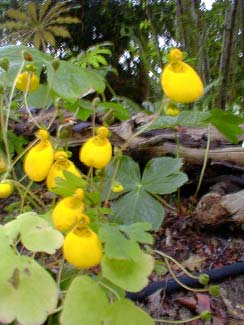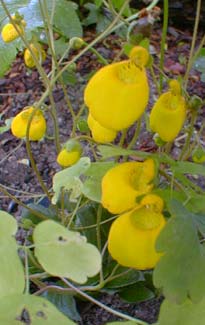
'Goldcap'
Pocketbook Flowers
"Still must the poet as of old,
In barren attic bleak & cold,
Starve, freeze, & fashion verses to
Such things as flowers & song & you."
-"To Kathleen"
by Edna St. Vincent Millay
(1892‚1950)
by Edna St. Vincent Millay
(1892‚1950)
I have rarely seen this little alpine Pocketbook Flower offered, but it is so charming & pretty it ought to be a standard.
There are other species sold as houseplants, but Calceolaria biflora 'Goldcap' lives outdoors. It is hardy at minus ten to zero degrees F., found even in the subantarctic regions. It is native of southern Chile & Argentina, from Catamarca to Tierra del Fuego, where carpets of this species are encountered blooming its heart out along the edges of snowmelts or on streambanks.
 "Hardy" is relative to other pocketbook flowers, as it is terribly tender here in the Pacific Northwest. Though easiest of a difficult lot, even 'Goldcap' can be difficult to get established & can rot away during winter. We planted several small clumps, half of which were still alive a year later, but all had vanished by the third year. More were planted to replace those which vanished, with the expectation that they might only be annuals, & they were, but floriferous while they were with us. Others have reported that they occasionall "take" & do very well & will spread, so we keep trying them in different locations.
"Hardy" is relative to other pocketbook flowers, as it is terribly tender here in the Pacific Northwest. Though easiest of a difficult lot, even 'Goldcap' can be difficult to get established & can rot away during winter. We planted several small clumps, half of which were still alive a year later, but all had vanished by the third year. More were planted to replace those which vanished, with the expectation that they might only be annuals, & they were, but floriferous while they were with us. Others have reported that they occasionall "take" & do very well & will spread, so we keep trying them in different locations.Even though they generally fail to perennialze they are still super performers as defacto annuals. In 2005, we planted them for the third time, in two locations, with fingers crossed that this time they do perennialize, though I no longer have much hope of it happening. Plus we planted the wild form which is a bit taller, & which we found for sale as C. falklandica which is synonymous with C. biflora.
Given a moist, humusy, cool, bright-shade location, it should have a very long bloom time from late spring to the end of summer, or longer. The flowers appear on slender stems rising eight inches to a foot above the almost succulent basal leaves. They are shown here in June photos, at over twice their actual size.
The names "Pocketbook Flower" & "Purse Flowers" are pretty much self-explanatory, as also the alternative name "Slipper Flower." Inside each puffy pocketbook is a dusting of red freckles not generally visible from the outside.
The basal leaves form pubescent semi-evergreen florets for year-round interest. Some discriptions say the basal leaves are fully evergreen, but in our garden they do eventually die back to the ground, & new small basal leaves begin to reappear in February, on the few plants that make it to their second year; the new growth remains quite small throughout March. My suspicion is their tenderness in Zone 8 is because they need to be colder & drier during winter, perhaps even under snowfall, as our wet winters more often than not doesn't spare them.
We've tried them in deep shade, in partial shade, & with more sunlight. All were located near irrigation since they so hate to dry out. All kept blooming & reblooming most excellently in their varied degrees of light & shade, but always only a few returned for a second year. The most recent planting has been tried in bright shade, this time in spots that will drain more sharply in winter, when they are most apt to die out of the garden not from the cold but from wetness during dormancy.
I'm not a great fan of annuals nor defacto annuals; I prefer strong definate perennials. But I keep trying this tender perennial because I find it so novel & charming & just love to see it in the garden. Curiously another species reportedly even more tender in our zone, C. integrifolia 'Kentish Hero,' has much more successfully perennialized in two locations, a sunny spot & a semi-shady spot, both locations draining particularly well in winter.